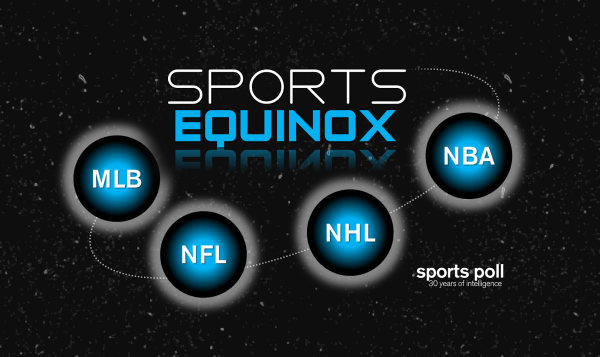Our presentation at the Quirk’s Event in New York City last summer included insights from our Sports Poll, the first sports fan intelligence product in the US. We explained how five fan dynamics can help drive lifetime engagement. Many of you wanted to know how our approach can be applied to your audience.
In our series, “Using Sports Poll Fan Dynamics to Drive Lifetime Engagement,” we explore each dynamic in more detail and provide research that shows them in action.
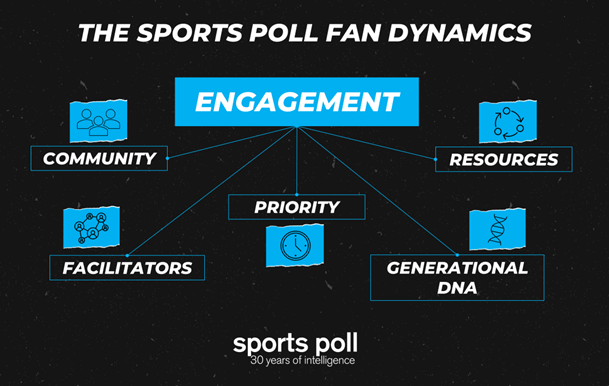
The five dynamics include: Priority, Community, Facilitators, Resources, and Generational DNA. Each dynamic is linked to higher fan engagement. The framework can apply to any type of free time activity, not just sports.
We covered Priority and Community in our first two releases. The third release of the series focuses on “Facilitators.” Read on to learn more about how facilitators can drive engagement for fans.
Facilitators Bring People Together and Enjoy Doing It
When you get together with family or friends, someone typically comes up with the idea and makes it happen. They choose the activity, coordinate plans, and buy the tickets. You can probably think of who this person is within your own family or social group immediately. It may even be yourself. We call the people who do this “facilitators” because they enjoy bringing a group together.
We first identified this segment in our work with baseball teams more than a decade ago.
When we interviewed fans, we kept hearing how many enjoyed the responsibility of bringing large groups to games. With that work serving as a foundation, Sports Poll began studying facilitators in the total population. Today, among Americans 12 and older, 21% of the population identify as facilitators (Sports Poll, Oct 2024-Sep 2025). By definition, they are the ones who: a) typically come up with the idea, and b) enjoy bringing family and friends together. Nearly 60% of them say they prefer social activities in their free time.
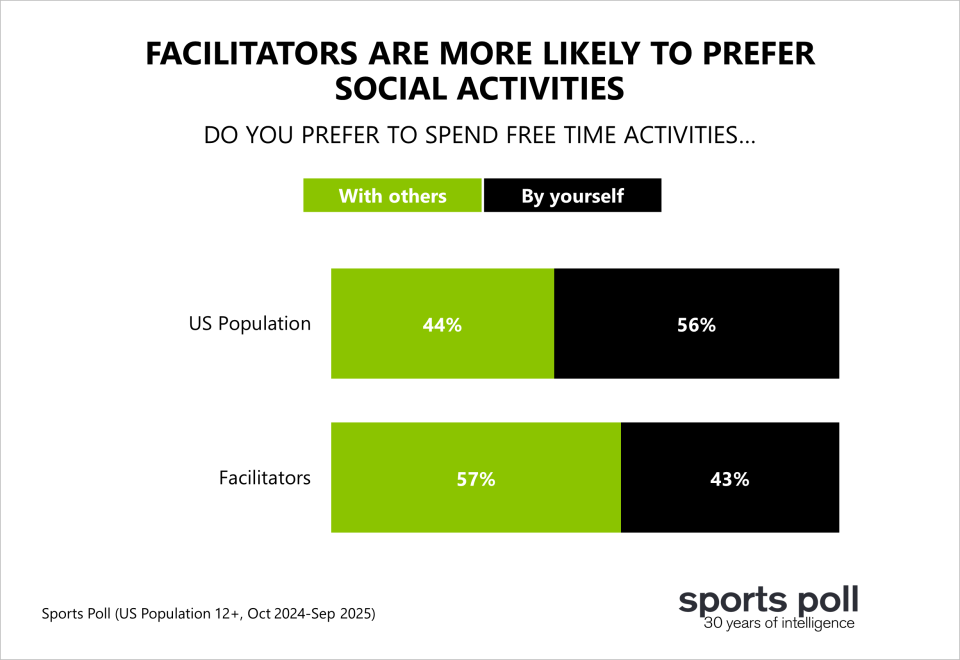
Facilitators Drive Ticket Sales
Not every ticket buyer is a facilitator, but they are responsible for a disproportionate amount of ticket sales. Facilitators bring an average of 4.7 people to a game (including themselves). This means that they account for nearly 5 sales every time they decide to attend.
Think of it like the 80/20 rule. Even though they only account for 21% of the population, their buying power extends far beyond. This goes even deeper in our work with pro and college teams. In previous work, we found that nearly 40% of season ticketholders identified as facilitators.
Who are facilitators demographically?
Certain groups within the population are more likely to identify as facilitators. They skew female (57%, compared to 51% of the population). They’re younger (56% vs. 51%), and they have more disposable money (59% earn $70,000 or more, compared to 53%). Not surprisingly, they also have stronger family connections.
Facilitators are more likely to have a child in the home (42% vs. 34%) and large households (57% have 3 or more in their household, compared to 51% of the population). Their larger family and work responsibilities also mean they have less free time than others, so there is a greater incentive to choose activities based on convenience.
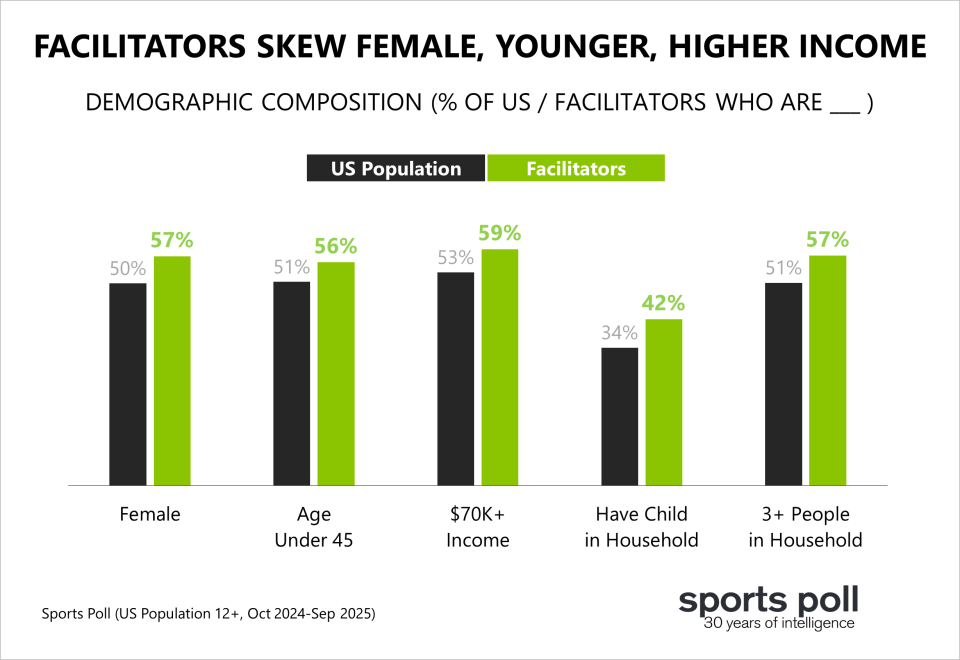
What social activities do facilitators choose?
Facilitators are big sports fans (38% are AVID fans, compared to 28% of the population), but sports is just one of many activities in their consideration set. Sports Poll asks people about the general free time activities they engage in each month.
Facilitators are more likely to attend sporting events, but they over-index on nearly every other social activity compared to the population. Restaurants, outdoor activities, and movies are their most common choices. With a finite amount of free time to allocate across their interests, there is a big upside financially when facilitators choose a specific activity over others.
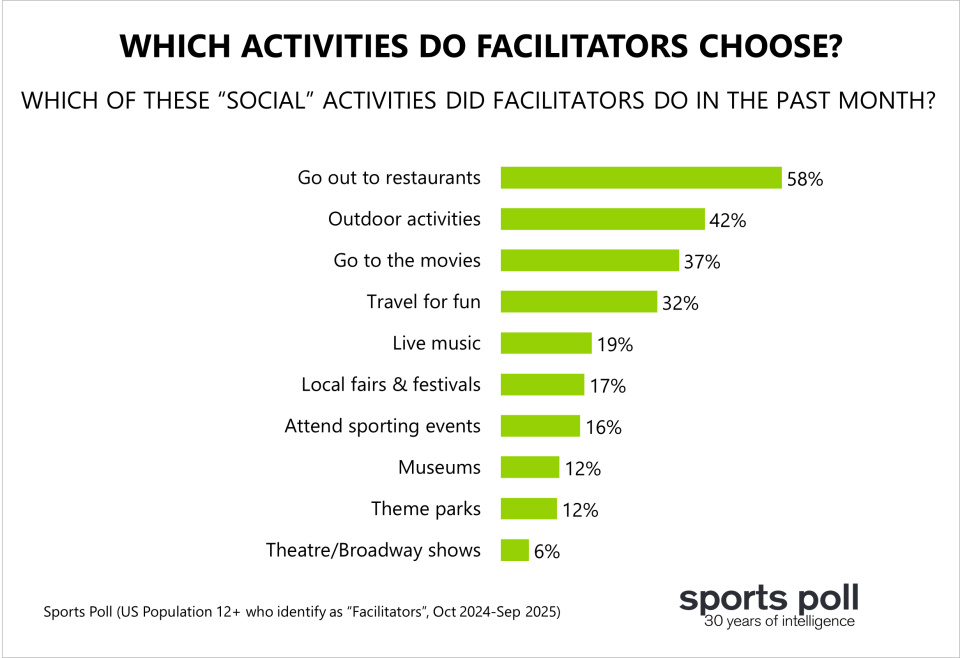
Facilitators don’t just choose activities because of their own personal interests. A big part of being a facilitator is wanting to create enjoyable experiences for the entire group. It helps to be interested in the activity, but it’s not essential. Even if a facilitator isn’t an AVID sports fan, sports will still be in their consideration set if there are other fans in their social group.
My mom is a perfect example. She isn’t a traditional AVID sports fan, but she’s been responsible for spending hundreds (if not thousands) of dollars a year on tickets, sporting goods, and other sports merchandise. As a facilitator, she does this because others in our household are AVID fans. Sports provides the pathway to enjoyable experiences for the family. Even though only 38% of facilitators identify as AVID sports fans themselves, 75% have at least one or more AVID fan in their household.
How to Leverage Facilitators
There is tremendous financial value when a facilitator chooses a specific social activity for family or friends. They’re not just buying one ticket but typically four or five at a time. It’s not just a one-time transaction. They will come back repeatedly if the group has a positive experience. Based on our work over the past ten years, we’ve identified a few simple steps to help maximize the value of facilitators:
Identify your facilitators.
This may seem obvious, but a simple first step is identifying who the facilitators are among attendees.
Emphasize their motives.
Knowing what drives their attendance decisions, it becomes easier to promote the elements most likely to attract their attention.
Overcome their constraints.
The biggest ones are obvious – time and money. Other constraints include lack of access, safety concerns, and limited awareness.
Recognize and reward them.
Facilitators bring people together because they enjoy it. If they are recognized and incentivized, they’ll be more likely to choose an activity again.




